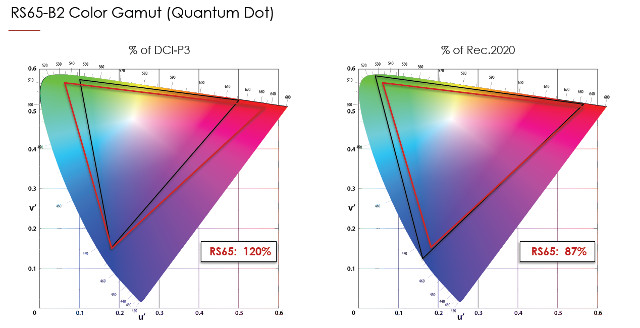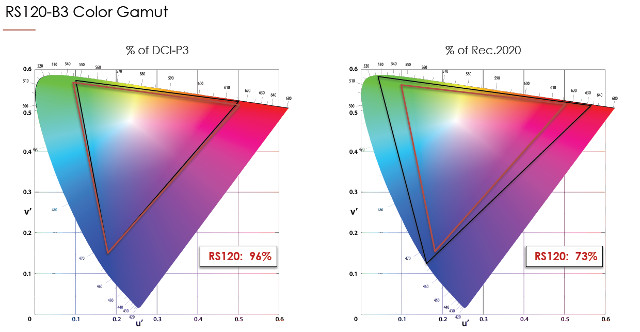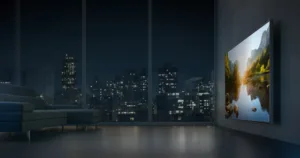Vizio, Dolby Laboratories and SpectraCal held a joint meeting and demonstration in New York on Oct. 6 to highlight the availability of the new Vizio Reference TVs along with HDR content mastered to the Dolby Vision Standard. SpectraCal was there to help reviewers and calibrators understand more about these new HDR TVs.
Vizio’s Reference series, announced at CES 2014, can now be pre-ordered on the company’s web site. There are two models in the series: the 65” RS65-B2 at an MSRP of $5,999.99 and the 120″ RS120-B3 model for $129,999.99 MSRP. These are clearly targeted for the custom install market with white glove installation service offered – and why SpectraCal’s new CalMAN v6.5 software calibration package will be needed.
Each set will offer a peak luminance of 800cd/m² using a full array backlight. There are 384 controllable zones in each set with 384 LEDs in the 65” but several LEDs in each zone of the 120”. The video black level is close to black as was shown in demos to be described later.
The 65” Reference TV also features a quantum dot film from 3M that achieves 87% of the 2020 gamut area (not coverage) and 120% of the P3 gamut area. The 120” model does not use a QD film as it can’t be made that large and stitching efforts to date have not been satisfactory. The 120” model uses an RG phosphor over blue LEDs to get a wide color gamut, but it is not as big as the QD version. Specifications are 96% coverage of the P3 gamut and 73% coverage of the 2020 gamut.


Most importantly, UHD content rendered in Dolby Vision HDR will also be available for the first owners of these TVs. VUDU has already announced it will stream Warner Bros. movies in Dolby Vision HDR to the Vizio Reference TVs with the first content being The Lego Movie, Edge of Tomorrow, Sherlock Holmes and Man of Steel. Upcoming titles from the studio include San Andreas, Mad Max: Fury Road, Magic Mike XXL, Jupiter Ascending, The Great Gatsby and more.
At the event, Dolby and Vizio announced that Netflix will also stream content mastered in Dolby Vision. First up will be the first season of Marco Polo with season 2 to premier in the format as well.
All seven major Hollywood studios have now agreed to master theatrical content in Dolby Vision HDR, which will play in Dolby HDR theaters. This content will then establish a pipeline to flow to the home as well.
Dolby has proposed a dual stream approach to delivering the HDR and SDR content to consumers. Vudu and Netflix will apparently adopt this approach, which is also an option in the new Blu-ray spec. In this approach, the base layer is a SDR/709 grade with metadata. The metadata is apparently embedded in the first two lines of the video signal. The second video stream contains elements needed to reconstruct an HDR version from the metadata. This is also dynamic metadata, meaning the way the HDR is rendered can vary from scene to scene (static metadata applies to the entire piece of content). If the content arrives at a legacy TV, the metadata and second stream are ignored and a SDR/709 image s created as usual. If the TV has the Dolby Vision decoder, an HDR signal is created.
The HDR rendering will actually be tailored to the capabilities of that TV. This information includes data such as the peak luminance, type of backlight and number of zones, color gamut capabilities and more. An algorithm will then try to create an HDR video that is visually faithful to the original master given the difference between the master display and the playback device. This will involve how to tone map from the 0-to-4000-cd graded master to the less-capable display of the end user. It will also decide how to map the P3 mastered colors to the capabilities of the TV. That’s putting a lot of trust in an algorithm that must be developed for each model that is Dolby Vision capable.
Note that the 65” Vizio TV has a color gamut in excess of P3, so colors should map directly to the native space of this display. Since there is very little content mastered in 2020, the extra color volume will essentially go unused, unless the end user goes out of calibrated mode and over saturates the TVs – which they will probably do.
Dolby Vision content is mastered at 12-bits per color with 4:2:2 color sampling. But this mode is not supported over HDMI. So, the signal must be converted to 8-bit 4:4:4 (same bandwidth) to go over HDMI 2.0 to the TV, where it is reconverted to 12-bit 4:2:2 for processing by the Dolby Vision chip. This is then delivered to the TV’s TCON, where it changes to 10-bits to drive the panel. Vizio and Dolby are still evaluating whether the HDMI 2.0a version will properly support Dolby Vision HDR transfer from external sources like Ultra HD Blu-ray players or set top boxes.
It is now clear that Dolby Vision mastered content will be in the P3 color space – not 2020. That is because the reference monitor that Dolby has sold to the studios only supports this color space – plus 4000 cd/m² of peak luminance.
Additional Reference Series Collection Features Include:
- Fast 802.11ac dual-band WiFi for improved streaming.
- VIZIO Internet Apps Plus for access to High Dynamic Range playback through VUDU and Ultra HD content through apps including Netflix, Amazon Instant Video, UltraFlix, and Toon Goggles.
- Discovery and organization of apps with support from the HEVC H.265 codec and the VIZIO V6 six-core processor.
- Clear Action 1800 and a 240 Hz effective refresh rate achieved with backlight scanning for improved motion clarity and a VM50 Engine for dedicated Ultra HD motion and picture-processing.
- A powerful Spatial Scaling Engine.
- Future-ready HDMI ports to help ensure usability of next generation cable and satellite receivers, Blu-ray players and game consoles.
- Integrated home theater audio in the 65″ class model supplemented by a powerful 10″ wireless subwoofer and two rear satellite speakers.
- Top-of-the-line audio technologies from Dolby and DTS, including over 101 dB of sound with less than 1% harmonic distortion.
The sets will be offered through installers of the PowerHouse Alliance of distributors and other custom installers – not through traditional TV distributors or retailers like Costco.
Analyst Comment
Dolby has clearly claimed the high ground in the race to create a new standard for image quality. They have worked for about a decade to create all of the pieces in a well thought out ecosystem from content creation, thru mastering and distribution right to the end user. It is a premium solution that not all will adopt, but many will envy. (CC)

